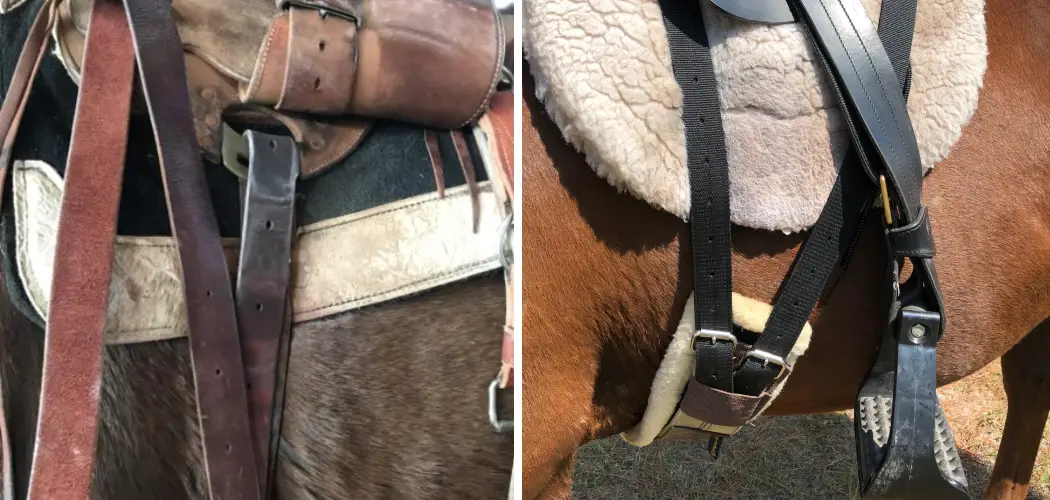Cinching a double D-ring saddle is a fundamental skill that every equestrian should master to ensure both the comfort of the horse and the rider’s safety.
The double D-ring saddle design offers stability and security, making it a popular choice among riders. Properly cinching the saddle is crucial for preventing discomfort, saddle shifting, and potential accidents during riding.
In this article, we delve into how to cinch a double d ring saddle, exploring the step-by-step process, essential considerations, and the significance of achieving the right balance between snugness and comfort.

Whether you’re a seasoned rider or a beginner, understanding the techniques to properly secure a double D-ring saddle ensures a smooth and enjoyable riding experience for both you and your equine partner.
Importance of Properly Cinching a Saddle
When it comes to the safety of you and your horse, making sure that your saddle is properly cinched is of utmost importance. Improperly cinching a Double D Ring Saddle can lead to an uncomfortable ride for both you and your horse, as well as potential accidents. That’s why we put together a simple guide on how to properly cinch a Double D Ring Saddle.
To begin, make sure that your saddle is properly positioned over the horse’s back and all of the straps are tightened before cinching. Next, take the cinch strap and pass it through the right side double d ring on the saddle.
Then loop it around to the left side of the saddle, making sure to keep it loose enough for your horse to breathe. Finally, secure the strap around the left side double d ring and pull until it is snug (not too tight).
Once you are finished cinching, make sure that the saddle lies flat against the horse’s back and that the straps are evenly distributed throughout. Inspect your work carefully before mounting your horse.
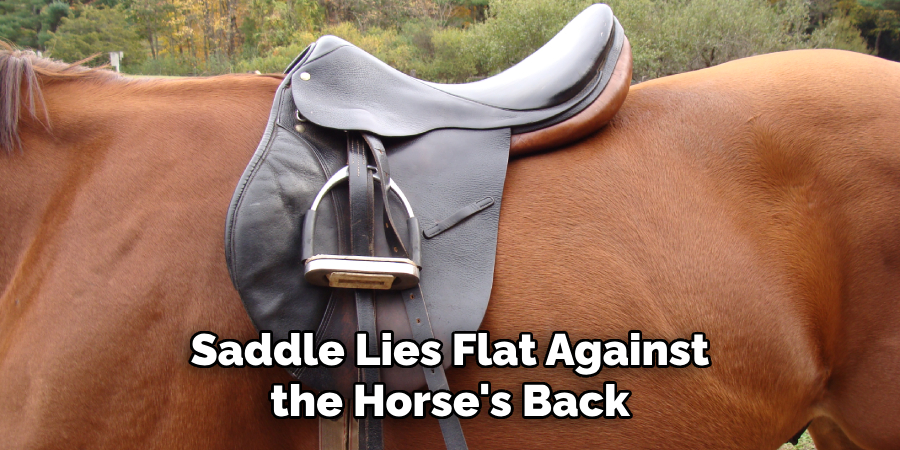
Safety Considerations for Rider and Horse
Safety is key when cinching or re-cinching a saddle. Be sure to check the tightness of the cinch before mounting. If it feels too tight, loosen it until you feel comfortable and safe.
Check the condition of your saddles’ cinches and stirrups regularly for broken stitching, fraying webbing, missing dees or broken buckles. A worn cinch can cause excessive movement of the saddle, leading to chafing and soreness on your horse’s back and a less secure ride for you both.
When tightening the cinch, keep it snug but not too tight. If you tighten it too much, it could cut off your horse’s circulation or cause them discomfort. To ensure a safe and comfortable cinch, use two fingers to check the tightness of the girth. If you’re able to fit two fingers between the girth and your horse’s body, it is appropriately snug.
When cinching or re-cinching your saddle, make sure that you never cross the buckles over each other. Doing so can create a weak point in the cinch that may break under pressure. Be sure to position the buckles on opposite sides of your horse’s body and pull them away from one another when tightening. .
10 Steps How to Cinch a Double D Ring Saddle
1. Groom and Prepare the Horse:
Proper grooming not only maintains the horse’s appearance but also ensures that the girth area is clean and free from any debris or sweat that could cause discomfort or chafing. This step sets the foundation for a comfortable ride and minimizes the risk of skin irritation.
2. Position the Saddle:
Carefully positioning the saddle is essential to distribute the rider’s weight evenly across the horse’s back. Placing the saddle behind the shoulder blades allows for unrestricted movement of the horse’s shoulders, preventing discomfort or pressure points.
3. Attach the Girth to the Saddle:
Begin the cinching process by attaching one end of the girth to the off-side (right side) D-ring of the saddle. The double D-rings provide added stability and prevent the saddle from slipping during the ride.
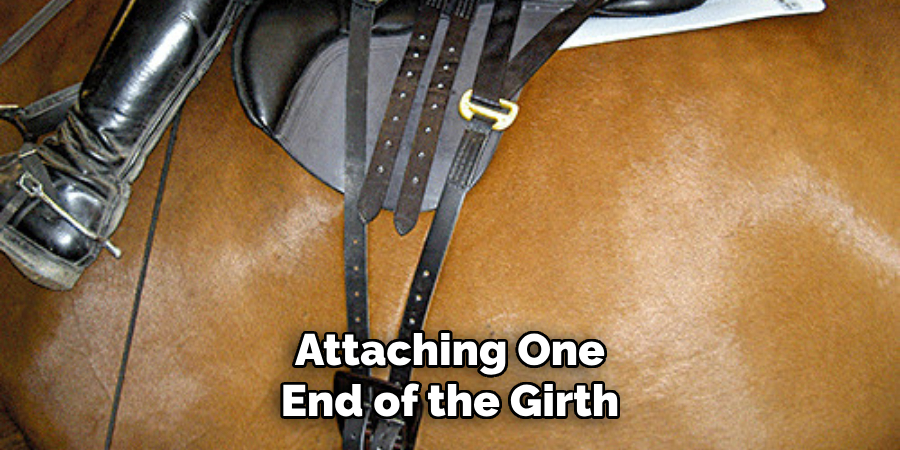
4. Move to the Near Side:
Moving to the near side (left side) of the horse ensures that the cinching process is carried out safely and smoothly. Positioning yourself on the opposite side from where you attached the girth prevents unnecessary pressure on the horse’s back.
5. Adjust the Girth Length:
Careful adjustment of the girth’s length is essential to avoid over-tightening or leaving it too loose. The goal is to achieve a snug fit that keeps the saddle secure while allowing the horse to breathe comfortably.
6. Secure the Girth Buckle:
Properly securing the girth buckle is crucial for maintaining the saddle’s position. Buckling the girth on the near side D-ring ensures that it remains securely in place throughout the ride.
7. Check for Comfort:
Running your hand along the horse’s girth area helps detect any folds or wrinkles in the skin that could indicate discomfort. Ensuring that the girth is positioned evenly and without any pinching is essential for a comfortable and safe riding experience.
8. Apply Even Pressure:
Achieving balanced pressure on both sides of the saddle is key to preventing uneven weight distribution. An improperly tightened girth can lead to the saddle sliding to one side, potentially causing discomfort and affecting the rider’s balance.
9. Recheck the Tightness:
As horses may breathe in deeply once mounted, it’s important to recheck the girth’s tightness after mounting. Maintaining a snug fit without causing excessive pressure is a dynamic process that ensures both rider and horse comfort.
10. Monitor During Riding:
During the ride, maintaining awareness of the girth’s tightness is essential. Horses’ bodies can change as they warm up or move, potentially affecting the fit of the girth. Regularly checking the girth’s snugness helps prevent the saddle from shifting and guarantees a secure riding experience.
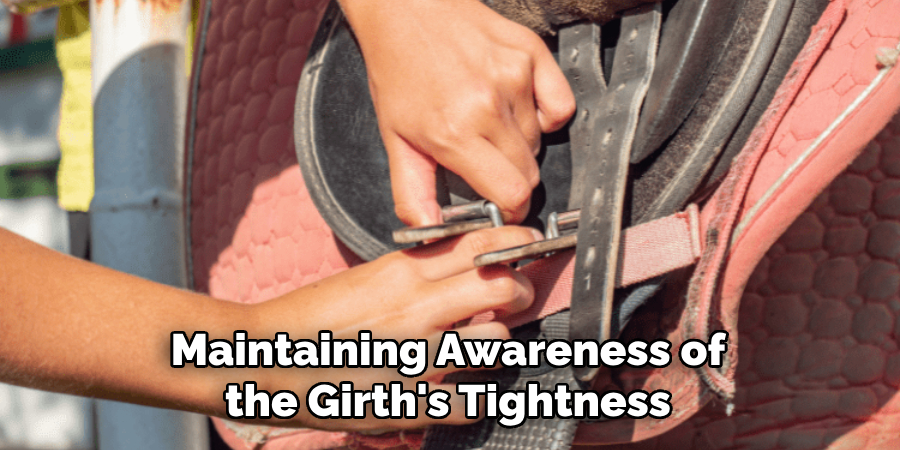
Safety Precautions for Cinching a Double D Ring Saddle
When it comes to cinching a Double D Ring saddle, safety should always be your top priority. To ensure the safety of both horse and rider, there are some key steps that should be taken before attempting to ride with this type of saddle.
First, make sure that the billets on the saddle are in good condition and free from any signs of wear and tear. They should be checked regularly for any signs of fraying, discoloration or any other damage that could compromise the safety of the saddle when in use.
The cinch also needs to be properly secured around the horse’s girth before mounting. This is done by looping the cinch through both D-rings at the front of the saddle and tying it in a secure knot. Be sure to tie it tightly enough that it won’t slip off during riding, but not too tight as this can cause discomfort for the horse.
Finally, when mounting with a Double D Ring saddle, make sure to use a mounting block or stirrup leathers for support while doing so. This helps to ensure that the rider is safely in the saddle and that there’s no chance of slipping off during use. It also helps to prevent any strain or stress on the horse from trying to mount without a block or leathers.
Common Mistakes to Avoid When Cinching a Double D Ring Saddle
When cinching a Double D Ring saddle, it is important to avoid any common mistakes that could put the rider and horse at risk. One of the most common mistakes is not checking the condition of the billets before riding. This should be done regularly to ensure that they are in good condition and free from any fraying or damage.
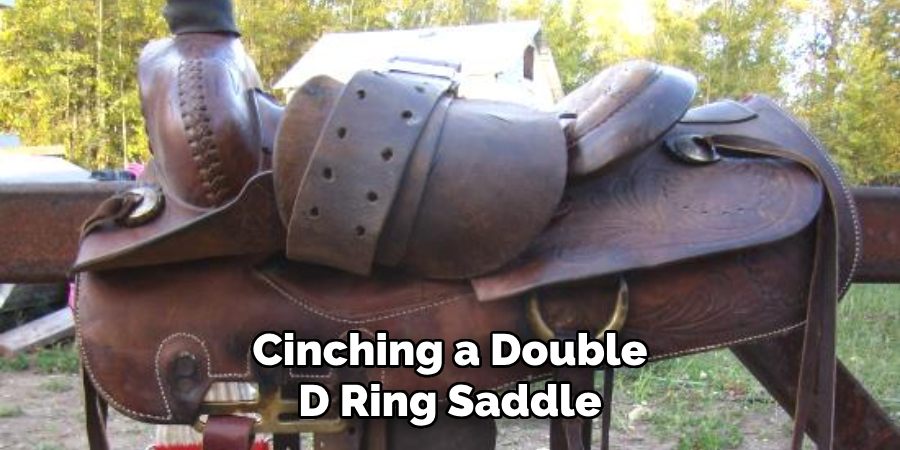
Another common mistake is incorrectly tightening the girth of the saddle by pulling too tightly on one side and not enough on the other. To ensure an even distribution of pressure, it is important to alternate between sides when cinching up a Double D Ring saddle.
Additionally, riders should always take their time to make sure that all buckles are securely fastened. This can be done by pulling on any slack straps and making sure they are firmly in place.
When it comes to the Double D Ring buckle, it is important to avoid over-tightening as this can cause the ring to bend or break. For this reason, make sure that you leave just enough room for two fingers between the ring and the strap once the cinch is securely fastened.
Conclusion
Now that you know how to cinch a double D ring saddle, all that’s left to do is get out there and apply what you’ve learned.
Not only can you use this skill for yourself, but it will also come in handy when helping out friends, family members, or anyone else who might need help with their saddles; plus, when at the barn, you’ll have the credibility of being able to quickly and correctly adjust your saddle’s girth with ease.
Gaining your newfound knowledge is one accomplishment, but demonstrating it successfully in practice is a whole other ballgame – so get out there and show off what you know! Who knows what challenges may arise from showing off your newfound talent, but they always seem to lead us further along our riding journey.
You Can Check It Out to Clean a Suede Saddle

